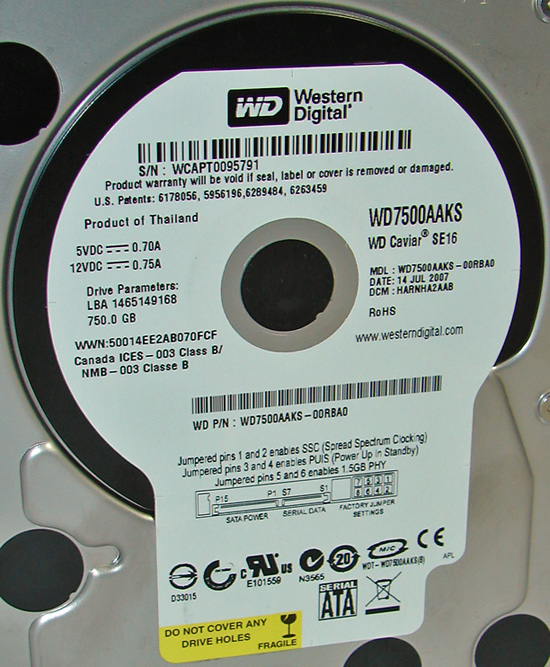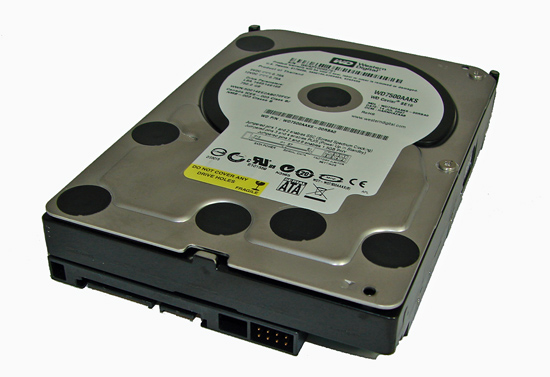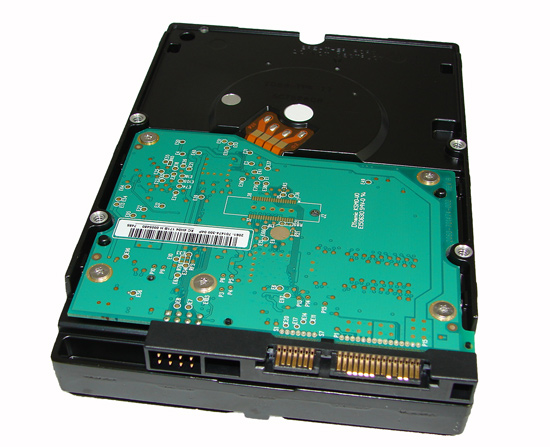Western Digital SE16 750GB: "Quiet" a Performer
by Dave Robinet on August 9, 2007 2:00 AM EST- Posted in
- Storage
Drive Specifications
The 750AAKS has technical specifications similar to its competition from Seagate and Hitachi. Seagate continues to offer the most attractive warranty, though the power consumption at load of the Western Digital is by far the lowest among its peers. Other specifications (seek time, latency, etc.) are all close enough as to be virtually indistinguishable among the drives.
The current street price for the Western Digital 750AAKS is around $190, while the Hitachi drive comes in at about $235 and the Seagate 7200.10 750GB at $199.
Feature Set

The 7500AAKS drive is equipped with all of the standard features found in the SE16 line, but has had two additional features added which are not present on the smaller capacity drives: Perpendicular Magnetic Recording (PMR), and StableTrac. PMR, which we've described in previous articles, is a means of achieving a higher data storage density (without changing the disk media). This is different than the more traditional method of longitudinal magnetic recording, which has nearly reached its limit in terms of data density. StableTrac, which is a proprietary technology by Western Digital, essentially means that the motor shaft is secured at both ends to reduce the effects (and generation) of vibration in the system.

The 7500AAKS is a 3.5" form factor drive, with the standard white Western Digital sticker outlining the basic specifications (capacity, drive parameters, etc).

Western Digital has followed the lead of other manufacturers in removing the 4 pin MOLEX connector on this drive which was used in older ATX power supplies. The SATA power port is therefore the only available power option.
| Hard Drive Specifications | |||
| Western Digital Caviar SE16 WD7500AAKS |
Hitachi Deskstar 7K1000 HDS721075KLA330 |
Seagate Barracuda 7200.10 ST3750640AS-RK |
|
| Stated Capacity | 750GB | 750GB | 750GB |
| Interface | SATA 3Gb/s | SATA 3Gb/s | SATA 3Gb/s |
| Rotational Speed | 7,200 RPM | 7,200 RPM | 7,200 RPM |
| Cache Size | 16 MB | 16 MB | 16 MB |
| Average Latency | 4.2 ms (nominal) | 4.17 ms (nominal) | 4.16 ms (nominal) |
| Read Seek Time | 8.9 ms | 8.5 ms | 8.5 ms |
| Number of Heads | 8 | 8 | 8 |
| Number of Platters | 4 | 4 | 4 |
| Power Draw Idle / Load | 8.6W / 10.7W | 8.1W / 12.8W | 8.6W / 12.6W |
| Command Queuing | Native Command Queuing | Native Command Queuing | Native Command Queuing |
| Warranty | 3 Year - Retail or OEM | 3 Year - Retail or OEM | 5 Year - Retail or OEM |
The 750AAKS has technical specifications similar to its competition from Seagate and Hitachi. Seagate continues to offer the most attractive warranty, though the power consumption at load of the Western Digital is by far the lowest among its peers. Other specifications (seek time, latency, etc.) are all close enough as to be virtually indistinguishable among the drives.
The current street price for the Western Digital 750AAKS is around $190, while the Hitachi drive comes in at about $235 and the Seagate 7200.10 750GB at $199.
Feature Set

The 7500AAKS drive is equipped with all of the standard features found in the SE16 line, but has had two additional features added which are not present on the smaller capacity drives: Perpendicular Magnetic Recording (PMR), and StableTrac. PMR, which we've described in previous articles, is a means of achieving a higher data storage density (without changing the disk media). This is different than the more traditional method of longitudinal magnetic recording, which has nearly reached its limit in terms of data density. StableTrac, which is a proprietary technology by Western Digital, essentially means that the motor shaft is secured at both ends to reduce the effects (and generation) of vibration in the system.

The 7500AAKS is a 3.5" form factor drive, with the standard white Western Digital sticker outlining the basic specifications (capacity, drive parameters, etc).

Western Digital has followed the lead of other manufacturers in removing the 4 pin MOLEX connector on this drive which was used in older ATX power supplies. The SATA power port is therefore the only available power option.










37 Comments
View All Comments
retrospooty - Thursday, August 9, 2007 - link
"There seems very little reason to even consider a Raptor anymore. "Except for hte fact that the Raptor 150 is 1 1/2 years old (thats older than the 7200.10 you mentioned) and a 300g Raptor, hopefully with 32m cache is also right around the corner. A300g Raptor with 32m cache will once again own the retail sector by a wide margin.
mostlyprudent - Thursday, August 9, 2007 - link
It will be interesting to see what new Raptor with 32MB of cache can do. I am still skeptical whether it will be able to manage the kind of performance advantage the Raptors had when they were first introduced. I personally think WD will have a tough time charging a significant price premium over other 300GB drives, let alone 750GB and 1TB drives.yyrkoon - Monday, August 13, 2007 - link
You mean the 'whopping' 58MB/s average ? The raptors when first released had issues. Less so now, and they perform much better. Not good enough to justify the cost in my opinion, but whatever floats your boat . . .
ceefka - Friday, August 10, 2007 - link
The Raptor would need more than 32MB cache to get (far) ahead of the pack again, like it did when it was first introduced. Three things they can do:1. Higher density platter :perpendicular
2. 15K rpm? I don't even know if that is possible, but it would be cool.
3. Like you said: 32MB or even more cache.
Martimus - Wednesday, August 15, 2007 - link
The higher density would slow it down, because the heads would need to be more precise. I think that is why the raptors always have less capacity than their caviar brand.retrospooty - Friday, August 10, 2007 - link
Right now the Raptor 150 is ahead of the pack with 16m cache vs 32, and a much lower density per platter, and no perpendicular storage. Add those 3 things and we might be cooking. I have heard rumors that 15k is in the works, but not confirmed.Basilisk - Thursday, August 9, 2007 - link
Or, you may need something loud enough to drown-out your partner's snoring. :)yyrkoon - Monday, August 13, 2007 - link
Funny that, I own a 750GB Seagate, the computer sits less than 4 feet from my head when I sleep up on a desk, and I cannot hear it. Now, If it were not the end of summer, and I were not living in the desert, had all my fans off, I MAY hear the occational disk chatter, but I'll be dahmed if it would ever keep me awake . . .Sometimes I wonder about some of you guys . . .
retrospooty - Thursday, August 9, 2007 - link
??? I dunno. I see AT's comparison always has the Raptor being loud, but I hafve had 1 36g 2 75g and 2 150g Raptors, none of them have been noisy at all, not even compared to other drives. Was I just lucky or is AT's samples unlucky?semo - Thursday, August 9, 2007 - link
is there a difference between the serial ata and the pata se16 wd drives?